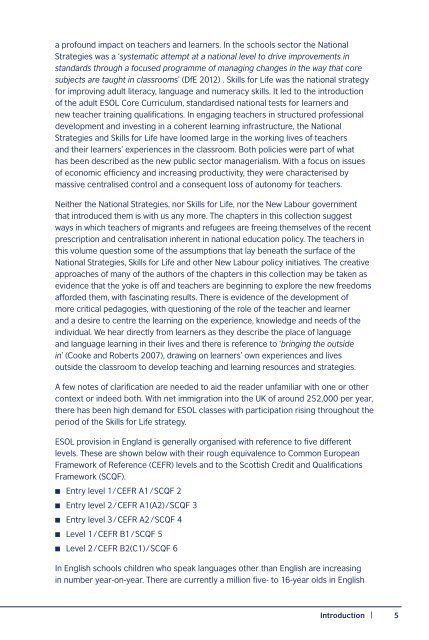Innovations in English language teaching for migrants and refugees
Innovations in English language teaching for migrants and refugees
Innovations in English language teaching for migrants and refugees
You also want an ePaper? Increase the reach of your titles
YUMPU automatically turns print PDFs into web optimized ePapers that Google loves.
a profound impact on teachers <strong>and</strong> learners. In the schools sector the National<br />
Strategies was a ‘systematic attempt at a national level to drive improvements <strong>in</strong><br />
st<strong>and</strong>ards through a focused programme of manag<strong>in</strong>g changes <strong>in</strong> the way that core<br />
subjects are taught <strong>in</strong> classrooms’ (DfE 2012) . Skills <strong>for</strong> Life was the national strategy<br />
<strong>for</strong> improv<strong>in</strong>g adult literacy, <strong>language</strong> <strong>and</strong> numeracy skills. It led to the <strong>in</strong>troduction<br />
of the adult ESOL Core Curriculum, st<strong>and</strong>ardised national tests <strong>for</strong> learners <strong>and</strong><br />
new teacher tra<strong>in</strong><strong>in</strong>g qualifications. In engag<strong>in</strong>g teachers <strong>in</strong> structured professional<br />
development <strong>and</strong> <strong>in</strong>vest<strong>in</strong>g <strong>in</strong> a coherent learn<strong>in</strong>g <strong>in</strong>frastructure, the National<br />
Strategies <strong>and</strong> Skills <strong>for</strong> Life have loomed large <strong>in</strong> the work<strong>in</strong>g lives of teachers<br />
<strong>and</strong> their learners’ experiences <strong>in</strong> the classroom. Both policies were part of what<br />
has been described as the new public sector managerialism. With a focus on issues<br />
of economic efficiency <strong>and</strong> <strong>in</strong>creas<strong>in</strong>g productivity, they were characterised by<br />
massive centralised control <strong>and</strong> a consequent loss of autonomy <strong>for</strong> teachers.<br />
Neither the National Strategies, nor Skills <strong>for</strong> Life, nor the New Labour government<br />
that <strong>in</strong>troduced them is with us any more. The chapters <strong>in</strong> this collection suggest<br />
ways <strong>in</strong> which teachers of <strong>migrants</strong> <strong>and</strong> <strong>refugees</strong> are free<strong>in</strong>g themselves of the recent<br />
prescription <strong>and</strong> centralisation <strong>in</strong>herent <strong>in</strong> national education policy. The teachers <strong>in</strong><br />
this volume question some of the assumptions that lay beneath the surface of the<br />
National Strategies, Skills <strong>for</strong> Life <strong>and</strong> other New Labour policy <strong>in</strong>itiatives. The creative<br />
approaches of many of the authors of the chapters <strong>in</strong> this collection may be taken as<br />
evidence that the yoke is off <strong>and</strong> teachers are beg<strong>in</strong>n<strong>in</strong>g to explore the new freedoms<br />
af<strong>for</strong>ded them, with fasc<strong>in</strong>at<strong>in</strong>g results. There is evidence of the development of<br />
more critical pedagogies, with question<strong>in</strong>g of the role of the teacher <strong>and</strong> learner<br />
<strong>and</strong> a desire to centre the learn<strong>in</strong>g on the experience, knowledge <strong>and</strong> needs of the<br />
<strong>in</strong>dividual. We hear directly from learners as they describe the place of <strong>language</strong><br />
<strong>and</strong> <strong>language</strong> learn<strong>in</strong>g <strong>in</strong> their lives <strong>and</strong> there is reference to ‘br<strong>in</strong>g<strong>in</strong>g the outside<br />
<strong>in</strong>’ (Cooke <strong>and</strong> Roberts 2007), draw<strong>in</strong>g on learners’ own experiences <strong>and</strong> lives<br />
outside the classroom to develop teach<strong>in</strong>g <strong>and</strong> learn<strong>in</strong>g resources <strong>and</strong> strategies.<br />
A few notes of clarification are needed to aid the reader unfamiliar with one or other<br />
context or <strong>in</strong>deed both. With net immigration <strong>in</strong>to the UK of around 252,000 per year,<br />
there has been high dem<strong>and</strong> <strong>for</strong> ESOL classes with participation ris<strong>in</strong>g throughout the<br />
period of the Skills <strong>for</strong> Life strategy.<br />
ESOL provision <strong>in</strong> Engl<strong>and</strong> is generally organised with reference to five different<br />
levels. These are shown below with their rough equivalence to Common European<br />
Framework of Reference (CEFR) levels <strong>and</strong> to the Scottish Credit <strong>and</strong> Qualifications<br />
Framework (SCQF).<br />
■■ Entry level 1 / CEFR A1 / SCQF 2<br />
■■ Entry level 2 / CEFR A1(A2) / SCQF 3<br />
■■ Entry level 3 / CEFR A2 / SCQF 4<br />
■■ Level 1 / CEFR B1 / SCQF 5<br />
■■ Level 2 / CEFR B2(C1) / SCQF 6<br />
In <strong>English</strong> schools children who speak <strong>language</strong>s other than <strong>English</strong> are <strong>in</strong>creas<strong>in</strong>g<br />
<strong>in</strong> number year-on-year. There are currently a million five- to 16-year olds <strong>in</strong> <strong>English</strong><br />
Introduction | 5


